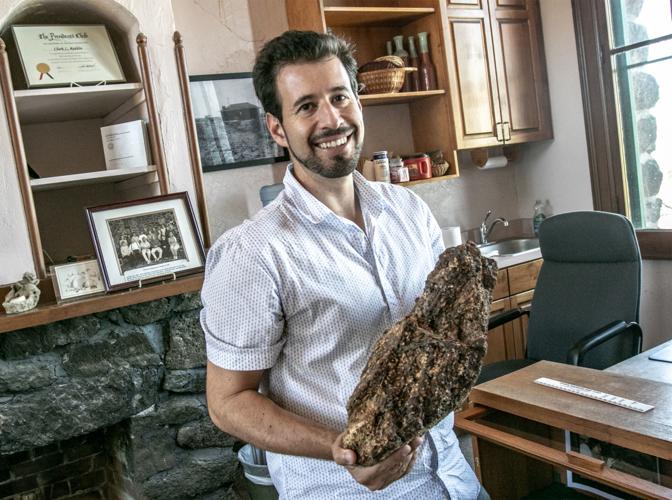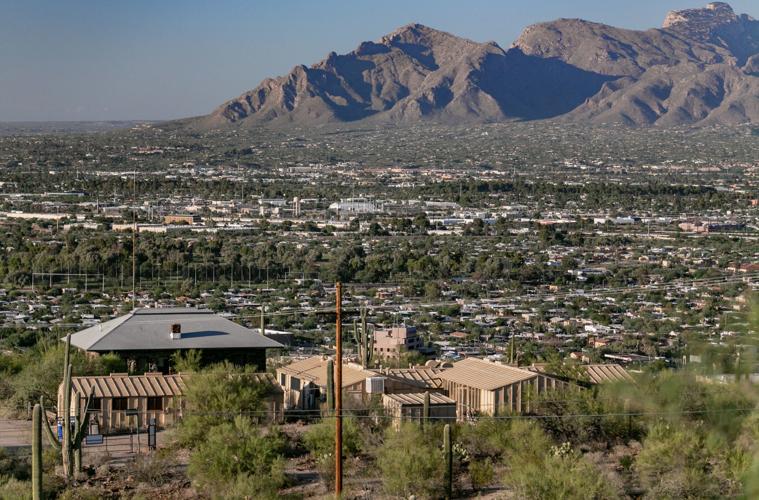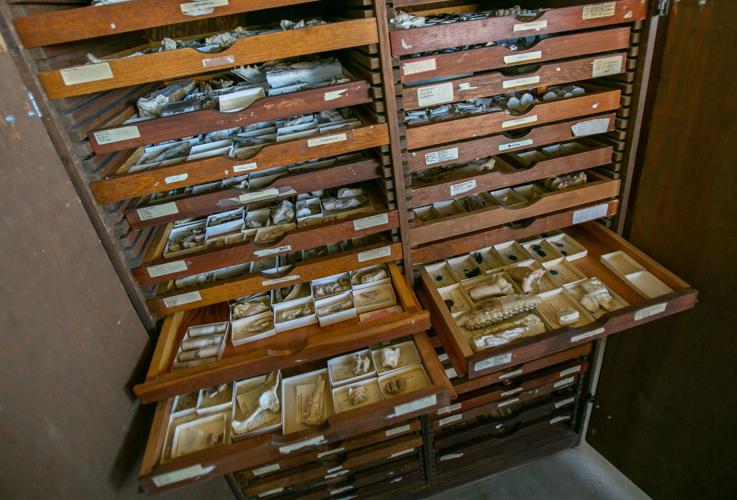Ben Wilder’s first job as an undergraduate student at the University of Arizona in 2004 was removing invasive bufflegrass from the slopes of Tumamoc Hill.
He is now the newly appointed director of the Desert Laboratory on Tumamoc Hill, an 860-acre ecological reserve and U.S. National Historic Landmark established by the Carnegie Institution in 1903 on Tucson’s west side. It has been owned and operated by the UA College of Science for more than 60 years and Pima County since 2009.
As director, Wilder hopes to not only honor the history of the hill — which stretches back thousands of years — but also re-establish it as a leader in desert ecology.
The hill, called Cemamagi Du’ag — hill of the horned lizard — in the Tohono O’odham language, is also a popular walking trail that draws more than 1,000 people a day. With this in mind, Wilder will also take the opportunity to launch many new public outreach programs ranging from public displays of fossils to citizen science to art programs.
Ultimately, the plan is to construct a visitor center at the base of the hill and repave the road up the hill, although those plans are still preliminary.
The walking path, which can be used by the public, will remain.
Fixing a fossil fiasco
In the fall of 2016, when Wilder was first appointed interim director, he stumbled across an extensive, yet unkempt fossil collection in a back room of a lab building on the hill.
He later learned it was compiled by a team of paleontologists from Tumamoc, primarily in the 1960s and 1970s. The majority of the fossils are from the rancholabrean time period that spanned 300,000 to about 11,000 years ago.
About one-third of the fossils in the collection are from the San Pedro River Valley that stretches from southeastern Arizona to northern Mexico.
“Over the decades, the collection was orphaned and abandoned,” Wilder said. “But Everett Lindsay (UA professor emeritus of geosciences) more than anyone, preserved the collection.”
Inside the lab’s back room, rows of wooden cabinets rotted. Dust has settled over trails of rat droppings and the tattered, stained papers that label the fossils held in wooden drawers. Pack rats left behind only thin wisps of cotton padding for the ancient bones to rest on.
About half of the sprawling collection is housed on Tumamoc, including large fish heads the size of serving trays and lower jaws of wooly mammoths. Larger pieces such as tusks and skulls are stored off campus.
“Oh my god, what am I going to do with this?” Wilder remembers.
Weeks later, retired paleontologist Jeff Saunders moved back to Tucson, where he earned his doctorate from the UA in 1975. He spent much of his graduate research time on Tumamoc and his adviser was Lindsay.
When Saunders returned from his 40-year career in Illinois, Lindsay recommended he help out around Tumamoc. Saunders is now a research scientist and curator of the paleontology collection for the Desert Lab.
Saunders and Jessica Harrison, a retired paleontologist also helping to curate the collection, were careful to not knock off any fossil remnants while brushing and vacuuming off years of neglect.
“You just have to make sure you don’t suck anything into the Shopvac,” Saunders said. “If you hear something going, ‘clink, clink,’ you have to excavate the bag.” Good thing they’re experts.
The cleaning is now complete, so the team has moved on to rehousing the fossils in new metal cabinets acquired through a $120,000 grant.
Eventually the off-site and on-site collections will be combined and housed in a new facility built in the same footprint as a dilapidated garage off the Tumamoc Hill parking lot. The space will be an active research lab. Visitors will be able to view the fossils through large windows.
Wilder is collaborating with the UA College of Architecture, Planning and Landscape Architecture to construct the new facility.
About 700 pack-rat middens in 200 boxes also will be added to the collection, Wilder said. The middens are not true fossils, but are capable of preserving vegetation trapped within crystallized rat urine.
“Scientists are always looking for time machines to understand the conditions far from when we are now,” Wilder said. “Pack-rat middens are the best time machines for vegetation and, by proxy, climate, in the last 50,000 years.”
Pack-rat middens revolutionized scientists’ understanding of the last ice age. For example, 13,000 years ago, the region was not desert but rather juniper oak woodland.
Additionally, both fossils and the middens can be mined for ancient DNA.
A mountain’s magnetism
“People are drawn to the top of the hill just as they have been for thousands of years, but 99 percent of the people don’t know the historical connection,” Wilder said. “They’re the most recent chapter participating in history. This place has had a magnetism for millennia.”
Wilder found that he has to balance preserving the sensitive site, which holds a 1,500-year-old village, with making the site accessible to the public.
“Thousands of years of history can be erased in a moment,” Wilder said. “First and foremost, we all need to be good stewards of the space.”
“Most of the science here has been focused on ecology, but we need to incorporate more of the cultural perspective of the people living here for thousands of years,” Wilder said.
A mobile app created in 2017 was a precursor to the many ways Wilder hopes to transform how visitors experience Tumamoc Hill. The app allows walkers to explore the ecological and archaeological history of the hill.
In the works is the development of the Tumamoc Transdiciplinary Arts Program. Resident artist Paul Mirocha, arts fellow Lyn Hart and writer Gary Nabhan are among those working toward building the mission of the program.
The next project, which is expected to go live sometime this fall, called “Cuéntame más: Tales from Tumamoc,” will capture the stories of the walkers and their connection to the place. It will be housed in a renovated mobile recording studio on the hill.
Additionally, art and science courses are becoming available to the public for a fee. The first course taught artists about the science of the Sonoran Desert while the scientists learned how to draw using observation. A second course will be held in the spring.
Tumamoc staff will also team up with the National Phenology Network to create a citizen science program. Walkers can document the timing of activities of certain species. The data will help them use species’ activities to indicate rapid shifts in the seasons.
The Desert Laboratory on Tumamoc Hill is driven by about 25 volunteers, two full-time employees and and one part-time employee.
With so much to be done, Tumamoc staff is developing a way to garner financial support from the community through the Friends of Tumamoc.
The most pressing issue is infrastructure. The buildings that contain office space, labs, archives of fossils and a library of scientific papers, maps, books and more are so old that window panels have warped with age and the facilities still rely on the original plumbing.
“If we don’t address that core issue, then it can just totally unravel what we do,” Wilder said.
But Wilder’s passion for the desert and the hill drive him. He’s still pulling bufflegrass to this day. But most importantly it’s the people who give Tumamoc meaning that drives him, he said.
“Just having a space that’s in the middle of a big city where every member of that community almost feels a sense of ownership to the point where they’re saying, ‘Who are you to tell me that I can’t walk Tumamoc?’ is powerful and speaks to the magnetism of the place ... so just being able to preserve it is a gift,” he said.











